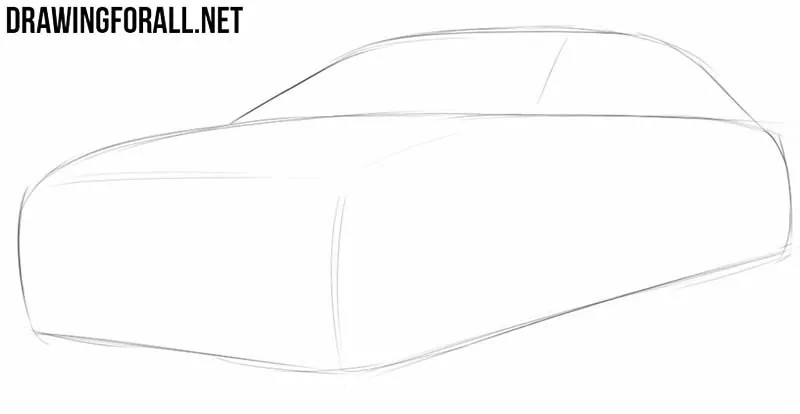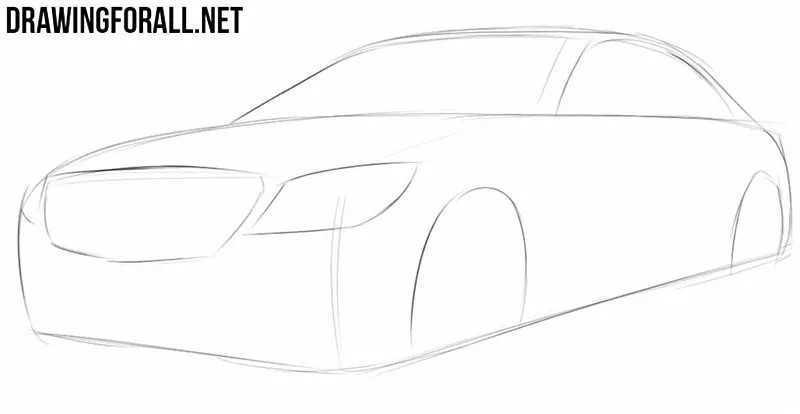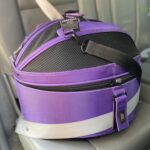Learning How To Draw A Car Step By Step can be a rewarding experience, opening doors to automotive design and artistic expression. At CARS.EDU.VN, we believe everyone can master this skill with the right guidance. This comprehensive guide will explore various techniques, provide step-by-step instructions, and inspire you to create stunning car drawings, incorporating key concepts like vehicle sketching and automotive illustration.
1. Understanding the Fundamentals of Car Drawing
Before we dive into the step-by-step process, it’s crucial to understand the foundational elements of car drawing. Just like any artistic endeavor, a solid understanding of these basics will significantly improve your results.
1.1. Perspective Drawing Basics
Perspective is the art of representing three-dimensional objects on a two-dimensional surface in a way that creates the illusion of depth and space. In car drawing, understanding perspective is essential for creating realistic and visually appealing illustrations.
- One-Point Perspective: In this type of perspective, all lines converge at a single vanishing point on the horizon line. This is useful for depicting cars viewed from directly in front or behind.
- Two-Point Perspective: Here, lines converge at two vanishing points on the horizon line. This is often used for drawing cars viewed from an angle, offering a more dynamic and realistic representation.
- Three-Point Perspective: This advanced perspective uses three vanishing points, including one above or below the horizon line. It’s employed for dramatic, bird’s-eye or worm’s-eye views of cars.
1.2. Basic Shapes and Proportions
Cars are complex objects, but they can be broken down into simpler shapes. Starting with these basic forms helps to establish the overall structure and proportions of the vehicle.
- Boxes and Rectangles: Use these to represent the main body, cabin, and engine compartment.
- Circles and Ovals: Ideal for drawing wheels and wheel arches.
- Cylinders: Helpful for representing exhaust pipes and other cylindrical components.
Establishing the correct proportions is also critical. A car’s proportions dictate its overall appearance and realism. Observe real cars and reference images to understand the relationships between different parts of the vehicle, such as the height of the roof relative to the length of the body.
1.3. Line Weight and Shading Techniques
The use of line weight and shading can add depth and dimension to your car drawings, making them more visually appealing.
- Line Weight: Varying the thickness of your lines can create emphasis and suggest depth. Thicker lines can be used for outlines and areas in shadow, while thinner lines can define details and highlights.
- Hatching and Cross-Hatching: These techniques involve drawing parallel or intersecting lines to create tonal variations and shading.
- Blending: Softening the edges of your shading can create a smooth, realistic effect, particularly on curved surfaces.
2. Step-by-Step Guide: Drawing a Car from Scratch
Now, let’s walk through a detailed, step-by-step guide on how to draw a car. This tutorial will focus on a generic sports car to illustrate the basic principles.
2.1. Step 1: Initial Sketch and Guidelines
Start with a light sketch to establish the basic shape and proportions of the car.
- Draw a Rectangle: This will serve as the main body of the car.
- Add a Second Rectangle: Position it on top of the first to represent the cabin.
- Sketch Wheel Arches: Use circles or ovals to roughly indicate the position and size of the wheels.
- Draw a Horizon Line: Lightly sketch a horizon line to help maintain perspective.
Alt text: Initial sketch showing basic rectangles and wheel arches for a car drawing.
2.2. Step 2: Refining the Body Shape
Refine the initial sketch to create a more accurate representation of the car’s body.
- Smooth the Lines: Round out the corners and edges of the rectangles to create a more aerodynamic shape.
- Define the Hood and Trunk: Sketch the sloping lines of the hood and trunk, paying attention to the car’s overall silhouette.
- Add the Windshield and Rear Window: Draw the angled lines of the windshield and rear window, connecting the cabin to the body.
2.3. Step 3: Adding Details: Windows, Doors, and Lights
Begin adding essential details to bring your car drawing to life.
- Draw the Windows: Sketch the side windows, paying attention to their shape and curvature.
- Add the Doors: Indicate the door lines and handles.
- Sketch Headlights and Taillights: Add the basic shapes of the headlights and taillights, positioning them accurately on the car’s front and rear.
Alt text: Sketching the details of headlights and windows to add realism to the car drawing.
2.4. Step 4: Drawing the Wheels and Rims
The wheels are a critical element of any car drawing.
- Draw the Tires: Refine the circles or ovals for the wheel arches into realistic tires.
- Add the Rims: Sketch the design of the rims inside the tires. Simple five-spoke designs are a good starting point.
2.5. Step 5: Adding More Details: Mirrors, Grille, and Bumpers
Continue adding smaller details to enhance the realism of your drawing.
- Draw the Side Mirrors: Sketch the side mirrors on either side of the car.
- Add the Grille: Draw the grille, including any horizontal or vertical bars.
- Sketch the Bumpers: Add the front and rear bumpers, paying attention to their shape and contour.
2.6. Step 6: Finalizing the Lines and Adding Shading
Once all the details are in place, it’s time to finalize the lines and add shading.
- Outline the Drawing: Use a pen or darker pencil to outline the entire car, emphasizing key features and contours.
- Erase Guidelines: Remove any unnecessary guidelines and construction lines.
- Add Shading: Use hatching, cross-hatching, or blending to add shadows and highlights, creating a sense of depth and volume.
Alt text: Final car drawing outline with detailed wheels and carefully placed shadows.
3. Advanced Techniques for Car Drawing
Once you’ve mastered the basics, you can explore more advanced techniques to take your car drawings to the next level.
3.1. Rendering Techniques
Rendering involves adding realistic lighting and surface details to your drawings.
- Highlighting: Use white or light-colored pencils to add highlights to shiny surfaces, such as the car’s body and windows.
- Shadows and Reflections: Carefully observe how light interacts with different surfaces and add shadows and reflections accordingly.
- Material Representation: Experiment with different rendering techniques to represent different materials, such as chrome, glass, and paint.
3.2. Drawing Different Car Styles
Different car styles have unique characteristics and proportions. Practice drawing a variety of car types, such as:
- Sedans: Known for their practicality and comfort.
- SUVs: Characterized by their ruggedness and versatility.
- Sports Cars: Emphasize performance and aerodynamics.
- Trucks: Designed for heavy-duty work and hauling.
3.3. Using Digital Tools
Digital drawing tools, such as drawing tablets and software like Adobe Photoshop or Procreate, offer a range of advanced features and capabilities.
- Layers: Use layers to organize your drawing and make it easier to edit and refine.
- Brushes: Experiment with different brushes to create various effects, such as smooth gradients and textured surfaces.
- Coloring: Add color to your drawings using digital painting techniques.
4. Common Mistakes to Avoid
Even experienced artists make mistakes from time to time. Here are some common pitfalls to avoid when drawing cars:
- Incorrect Proportions: Always double-check the proportions of your drawing to ensure accuracy.
- Lack of Perspective: Pay attention to perspective to create a realistic sense of depth and space.
- Poor Line Quality: Use clean, confident lines to create a professional-looking drawing.
- Inconsistent Shading: Ensure that your shading is consistent and reflects the light source accurately.
5. Inspiration and Resources for Car Drawing
To improve your car drawing skills, it’s essential to seek inspiration and utilize available resources.
5.1. Online Tutorials and Courses
Numerous online tutorials and courses can help you learn how to draw cars. Websites like YouTube, Skillshare, and Udemy offer a wealth of instructional content for artists of all levels.
5.2. Reference Images
Using reference images is crucial for creating accurate and realistic car drawings. Websites like Pinterest, Google Images, and automotive magazines offer a vast collection of high-quality reference photos.
5.3. Automotive Design Communities
Joining online automotive design communities can provide valuable feedback, inspiration, and networking opportunities. Websites like Behance and Dribbble are great platforms for showcasing your work and connecting with other artists.
6. The Art of Automotive Illustration
Automotive illustration is a specialized field that combines artistic skill with technical knowledge of cars. It involves creating detailed and visually appealing renderings of vehicles for various purposes, such as advertising, marketing, and design.
6.1. Understanding Automotive Design
A solid understanding of automotive design principles is essential for creating effective automotive illustrations. This includes knowledge of:
- Vehicle Architecture: The basic structure and layout of a car.
- Styling Trends: Current and historical trends in automotive design.
- Aerodynamics: How air flows around a car and affects its performance.
6.2. Developing Your Own Style
While it’s important to learn from other artists, it’s also crucial to develop your own unique style. Experiment with different techniques, materials, and approaches to create a look that is distinctly yours.
6.3. Building a Portfolio
A strong portfolio is essential for showcasing your skills and attracting clients. Include a variety of car drawings in your portfolio, demonstrating your versatility and expertise.
7. CARS.EDU.VN: Your Partner in Automotive Education and Services
At CARS.EDU.VN, we understand the passion and dedication required to master automotive skills, whether it’s drawing cars or maintaining them. We strive to provide comprehensive information and resources to car enthusiasts and professionals alike.
7.1. Comprehensive Automotive Information
CARS.EDU.VN offers a wealth of information on various automotive topics, including:
- Car Reviews and Comparisons: In-depth reviews and comparisons of different car models.
- Maintenance and Repair Guides: Step-by-step guides on how to maintain and repair your vehicle.
- Automotive News and Trends: The latest news and trends in the automotive industry.
7.2. Reliable Repair Services
Finding reliable and trustworthy repair services can be a challenge. CARS.EDU.VN connects you with certified mechanics and repair shops in your area, ensuring that your car receives the best possible care.
7.3. Expert Advice and Support
Our team of automotive experts is available to answer your questions and provide guidance on any car-related issue. Whether you need help choosing the right car or troubleshooting a mechanical problem, we’re here to help.
8. Top 5 Search Intentions for “How to Draw a Car Step by Step”
Understanding the search intentions behind the keyword “how to draw a car step by step” is crucial for creating content that meets the needs of users. Here are five common search intentions:
- Beginner Tutorials: Users looking for simple, easy-to-follow tutorials for drawing basic car shapes.
- Detailed Car Models: Individuals seeking advanced tutorials for drawing specific car models with intricate details.
- Drawing Techniques: Artists interested in learning different drawing techniques, such as perspective, shading, and rendering.
- Digital Car Drawing: Users looking for tutorials on drawing cars using digital tools and software.
- Car Design Inspiration: People seeking inspiration and ideas for their own car designs and illustrations.
9. SEO Optimization for Car Drawing Content
To ensure that your car drawing content ranks well in search engine results, it’s essential to optimize it for SEO.
9.1. Keyword Research
Identify relevant keywords that users are searching for, such as:
- “How to draw a car step by step”
- “Car drawing tutorial”
- “Easy car drawing”
- “Automotive illustration”
- “Vehicle sketching”
9.2. On-Page Optimization
Optimize your content by:
- Using Keywords in Titles and Headings: Include relevant keywords in your titles, headings, and subheadings.
- Writing High-Quality Content: Create informative, engaging, and well-written content that provides value to users.
- Optimizing Images: Use descriptive alt tags for your images, including relevant keywords.
- Ensuring Mobile-Friendliness: Make sure your website is mobile-friendly, as a significant portion of users access the internet on their mobile devices.
9.3. Off-Page Optimization
Build authority and credibility by:
- Earning High-Quality Backlinks: Get links from reputable websites in the automotive and art industries.
- Promoting Your Content on Social Media: Share your content on social media platforms to reach a wider audience.
- Engaging with Your Audience: Respond to comments and questions from your audience, building a community around your content.
10. E-E-A-T and YMYL Considerations
When creating content on topics related to cars, it’s important to adhere to Google’s E-E-A-T (Experience, Expertise, Authoritativeness, and Trustworthiness) and YMYL (Your Money or Your Life) guidelines.
- Experience: Share personal experiences and insights related to car drawing and automotive design.
- Expertise: Demonstrate your knowledge and skills in car drawing by providing detailed tutorials and technical information.
- Authoritativeness: Cite reputable sources and experts in the automotive and art industries.
- Trustworthiness: Be transparent about your credentials and affiliations, and provide accurate and unbiased information.
By following these guidelines, you can create content that is not only informative and engaging but also trustworthy and credible.
11. FAQ: Common Questions About Car Drawing
Here are some frequently asked questions about car drawing:
- What are the basic shapes used in car drawing? Common shapes include rectangles, circles, and ovals.
- How do I create realistic shading in my car drawings? Use techniques like hatching, cross-hatching, and blending.
- What are the different types of perspective used in car drawing? One-point, two-point, and three-point perspective.
- What are some common mistakes to avoid when drawing cars? Incorrect proportions, lack of perspective, and poor line quality.
- What are some resources for learning how to draw cars? Online tutorials, reference images, and automotive design communities.
- How can I develop my own style in car drawing? Experiment with different techniques, materials, and approaches.
- What is automotive illustration? A specialized field that combines artistic skill with technical knowledge of cars.
- What are some essential skills for automotive illustrators? Understanding automotive design, rendering techniques, and digital drawing tools.
- How can I build a portfolio of car drawings? Include a variety of car drawings in your portfolio, demonstrating your versatility and expertise.
- Where can I find reliable information about cars and automotive services? CARS.EDU.VN offers a wealth of information and resources.
12. Stay Updated on the Latest Car Models and Technologies
The automotive industry is constantly evolving, with new car models and technologies being introduced regularly. Keeping up-to-date with these developments is essential for creating relevant and engaging car drawings.
12.1. New Car Model Releases
Here’s a table showcasing some of the latest car model releases:
| Make | Model | Release Date | Key Features |
|---|---|---|---|
| Tesla | Model Y (2024) | Q1 2024 | Enhanced autopilot, improved battery range, updated interior design. |
| Ford | F-150 Lightning | Q2 2024 | All-electric pickup truck, advanced towing capabilities, spacious cabin. |
| BMW | i5 | Q3 2024 | Electric executive sedan, luxurious interior, state-of-the-art technology. |
| Chevrolet | Corvette E-Ray | Q4 2024 | Hybrid sports car, all-wheel drive, impressive acceleration. |
| Mercedes | EQS SUV | Q1 2025 | Electric SUV, advanced driver-assistance systems, luxurious amenities. |



12.2. Advanced Automotive Technologies
Here’s a list of some notable advancements in automotive technology:
- Electric Vehicles (EVs): EVs are becoming increasingly popular due to their environmental benefits and improved performance.
- Autonomous Driving: Self-driving technology is rapidly advancing, with many cars now offering advanced driver-assistance systems (ADAS).
- Connectivity: Cars are becoming more connected, offering features like over-the-air updates, smartphone integration, and cloud-based services.
- Advanced Materials: Lightweight materials like carbon fiber and aluminum are being used to improve fuel efficiency and performance.
- Augmented Reality (AR): AR technology is being used in car dashboards and windshields to provide drivers with real-time information and enhanced visibility.
13. Call to Action: Explore More with CARS.EDU.VN
Are you struggling to find reliable car repair services or overwhelmed by the complexities of vehicle maintenance? Do you dream of drawing cars with precision and artistry but need expert guidance?
At CARS.EDU.VN, we’re dedicated to providing you with the resources and support you need to succeed. Whether you’re seeking in-depth car reviews, step-by-step repair guides, or inspiration for your next automotive illustration, we’ve got you covered.
Visit CARS.EDU.VN today to explore our comprehensive collection of articles, tutorials, and expert advice. Let us help you unlock your automotive potential.
Contact us:
- Address: 456 Auto Drive, Anytown, CA 90210, United States
- WhatsApp: +1 555-123-4567
- Website: CARS.EDU.VN
By following this comprehensive guide and utilizing the resources available at cars.edu.vn, you can master the art of car drawing and embark on a rewarding journey of artistic expression and automotive exploration.
